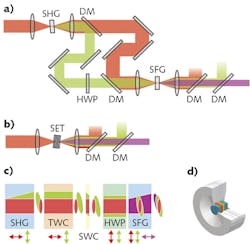Frequency Conversion: Compact optical design and pulse modeling improve nonlinear frequency conversion efficiency
Although near-infrared (near-IR) ultrafast laser pulses are readily available via ytterbium (Yb)-doped and Ti:sapphire lasers, near-ultraviolet (200–400 nm) pulses are usually obtained through frequency-conversion methods such as second- and third-harmonic generation (THG). Unfortunately, even when obtained in this manner using nonlinear materials, conversion efficiencies for conventional THG of unamplified femtosecond laser pulses are only 6–11% because of dispersion and group-velocity mismatch, diffraction, spatial walk-off, and angular phase-matching acceptance issues.
A new method from researchers at the University of Warsaw (Warsaw, Poland) uses a single-element tripler (a sandwich of nonlinear and linear crystals) and a holistic model that optimizes frequency-conversion parameters to enable conversion efficiencies up to 30%—a threefold improvement compared to conventional methods.1
Nonlinear sandwich
In conventional frequency-tripling setups, the second-harmonic frequency generated from a doubling nonlinear crystal is separated from the transmitted fundamental wave so that compensation for temporal and spatial walk-off and polarization-rotation effects is achieved. The second harmonic is then joined by the primary or fundamental wave in the sum-frequency generation (SFG) crystal and THG is completed.
"Through simple step-by-step optimization of the standard THG setup, approximately 10% tripling efficiency is as good as one can get and the progress seemed to have stopped here for a decade or so," says Michał Najbauer from the team of researchers based at the Faculty of Physics of the University of Warsaw.
Alternatively, in the University of Warsaw design, second-harmonic generation (SHG), temporal and spatial walk-off compensation, polarization management, and SFG all occur in a nonlinear crystal sandwich (see figure). In the first crystal, the second harmonic and fundamental pulse also travel different paths with different delays, although spatial walk-off is compensated in a yttrium vanadate (YVO4) plate with a walk-off angle >6°—a more-robust scheme than inverted nonlinear crystals with independent tilt values.
A calcite crystal serves as a birefringent plate for temporal walk-off compensation, and the fundamental pulse polarization is rotated 90° using a quartz half-wave plate. This configuration ensures that angle tuning of SHG and SFG phase-matching uses two perpendicular axes of rotation. The five crystals are then assembled together with small (0.1 mm) gaps in between.
In addition to this single-element tripler, a Matlab-based modeling environment called Hussar was developed that models one-, two-, and three-dimensional models of broadband light fields as they propagate in linear and nonlinear media. Hussar not only optimizes THG using the tripler, but can also solve problems in supercontinuum generation, non-collinear three-wave, and four-wave mixing architectures.
"The open-source simulation package was developed to allow the user to build a complex 3D simulation of multiple pulse propagation using basic blocks: input pulse parameters, material properties, and process dynamics," says Tomasz Kardaś, who developed the software. After defining the input pulse parameters such as energy, duration, and spatial beam profile, the software searches for the best design over a large space of parameters: the nonlinear-crystal thicknesses, the beam size, the beam-waist position, and others.
"What came as a surprise for the device built with these optimum parameters was that the measured performance agrees very well with the simulations," adds Kardaś. "This kind of quantitative agreement between what one gets on the screen and then measures in the lab is very rare in nonlinear optics."
Modeling optimizes parameters of the single-element tripler including nonlinear-crystal thickness, compensation-plate thickness, and geometry for each of the optical elements. Using the tripler stack to frequency-convert a 2.7 W, 1040 nm laser source, 640 mW of THG light was obtained—a 24% conversion efficiency. In additional experiments, conversion efficiencies to the third harmonic as high as 31% were obtained.
"The compact tripler was developed in close collaboration with industrial partners-leading laser companies from the EU and Switzerland," says Piotr Wasylczyk, who was the project principal investigator at the University of Warsaw. "We hope to develop this initial concept into a final product, possibly integrated directly into femtosecond laser heads."
REFERENCE
1. T. M. Kardaś et al., Nat. Sci. Rep., 7, 42889 (2017); http://www.nature.com/articles/srep42889.

Gail Overton | Senior Editor (2004-2020)
Gail has more than 30 years of engineering, marketing, product management, and editorial experience in the photonics and optical communications industry. Before joining the staff at Laser Focus World in 2004, she held many product management and product marketing roles in the fiber-optics industry, most notably at Hughes (El Segundo, CA), GTE Labs (Waltham, MA), Corning (Corning, NY), Photon Kinetics (Beaverton, OR), and Newport Corporation (Irvine, CA). During her marketing career, Gail published articles in WDM Solutions and Sensors magazine and traveled internationally to conduct product and sales training. Gail received her BS degree in physics, with an emphasis in optics, from San Diego State University in San Diego, CA in May 1986.
